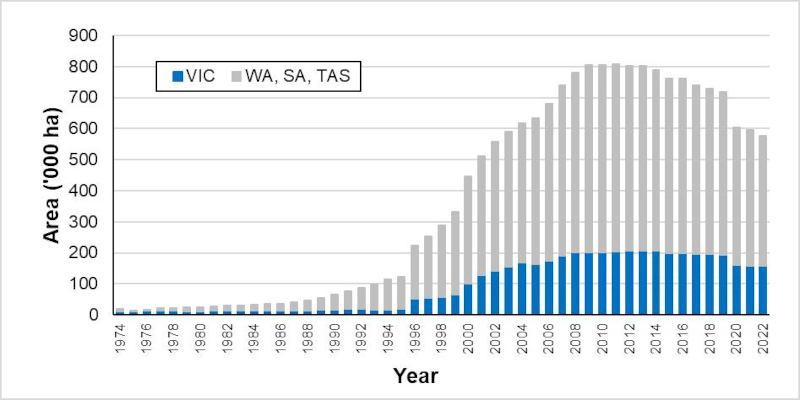Native Hardwood Plantations in Victoria
T Baker
Victoria’s hardwood plantation area expanded rapidly from the mid-1990s to a peak area of about 210,000 ha in 2012 and was about 160,000 ha in 2022. This expansion – dominantly onto agricultural land – and recent contraction paralleled that for southern Australia (Fig. 1).

Figure 1. Hardwood Plantation Area in Southern Australia 1
Prior to the mid-1990s, much of the Victorian area (total <20,000 ha) included that from Eucalyptus regnans reforestation in the Strzelecki ranges and E. nitens reforestation on the Tooronga Plateau2, and development of E. globulus and E. nitens plantations in the central Gippsland region (Latrobe Valley and ranges3). There were also relatively small areas of E. cladocalyx in western and north-western Victoria4, and (irrigated) poplar in north-eastern Victoria5.
The subsequent expansion of hardwood plantation area was mostly of E. globulus in the Green Triangle, Central Victoria and Central Gippsland National Plantation Inventory (NPI) regions6; some E.nitens in the latter two regions (Strzelecki Ranges and Otway Ranges respectively); some E. globulus in the Murray Valley Region (Strathbogie Ranges and north-eastern Victoria) and some E. nitens inEast Gippsland. A range of eucalypt species were also planted across Victoria in agroforestry and farm-forestry experiments and demonstrations, but the total area of these was relatively small.
The expansion of the hardwood plantation area from the 1990s was primarily for export woodchip markets (for Victoria ex Portland, Geelong and Eden ports), and for additional/alternative pulpwood for papermaking at the Maryvale mill in Gippsland. Like elsewhere across southern Australia the Victorian expansion was largely funded through foreign investment (including joint ventures with Australian companies) and Australian managed investment schemes. Much of the hardwood estate is presently held by institutional investors. The State of Victoria recused itself from investment in large-scale hardwood plantation expansion, but through several initiatives directly supported some farm-forestry establishment, and generally provided some research and development (R&D) and extension support with a focus on solid wood production.
The wider Victorian R&D contribution to the development of the hardwood plantation estate was supported by or provided through Commonwealth and State policy initiatives, programs and agencies; by private industry; and formal and informal project collaborations including: National Afforestation Program; Victorian Joint Agroforestry Management Committee; East Gippsland Forest Agreement; Victorian Private Forestry Unit; Victorian Farm Forestry Network (e.g. Farm Forestry NE Victoria); Trees for Profit Program; West Victoria RFA Farm Forestry; Sawlogs for Salinity; Australian Research Council, Joint Venture Agroforestry Program; Rural Industries Research and Development Corporation (e.g. Growth of Key Agroforestry Species and Fast Growing Irrigated Eucalypt Plantations projects); Forest and Wood Products Australia (e.g. Value-Adding Silvicultural Regimes project); Australian Centre for International Agricultural Research (e.g. Cold Tolerant Eucalypts and Eucalypts and Water projects); CRC for Forestry 2005–2012; Tree Breeding Australia; Australian Low Rainfall Tree Improvement Group; FloraSearch; Forestry SA; Forestry Tasmania; Private Forests Tasmania (Farm Forestry Toolbox), CSIRO; and The University of Melbourne. APM Forests Pty Ltd, Midway Wood Products Pty Ltd and Timbercorp Ltd were notable industry contributors to and active participants in Victorian R&D. The establishment of the Centre for Forest Tree Technology7 in 1993 particularly enabled the State to undertake contract R&D and provide fee-for-service technical services (e.g. soil and plant testing) to industry.
Over some six decades Victorian scientists and technicians have contributed significantly to plantation R&D in tree improvement (selection and breeding); site and species selection; soils (including cultivation); tree nutrition and fertiliser responses; weed control; thinning and pruning; pests and diseases; growth and yield (including modelling); and wood properties. The work has included establishment of multi-experiment focus research sites including at Buffalo River, Tostaree and Shepparton; and (excluding tree breeding, and numerous farm forestry and agroforestry trials 8) more than 150 individual experiments across Victoria.
The bibliography lists (chronologically) published work from silvicultural R&D in Victorian hardwood plantations. However, there is a deal of unpublished R&D material (including commercial-in confidence) that is variously held and accessible. Data, results and information from both published and unpublished work were accessed for a recently completed project Optimising Productivity of Hardwood Plantations: Yield Gap Analysis for Eucalyptus globulus Plantations in Southern Australia (McGrath et al. 2024), and are being further analysed with those from current experiments in a collaborative project: Enhancing the Knowledge Base for Hardwood Plantation Management.9
Several people assisted in the compilation of the bibliography, including D Flinn and J Sasse. The bibliography will remain a work-in-progress, with periodic updates, and further contributions (and corrections) are welcome.10
References
1 Australian Plantation Statistics Update
2 Reforesting - An Overview
3 APM Forests - A Glimpse of the 90s
4 Early Hardwood Plantations
5 Trees for Special Purposes: Wastewaters and Saline Land - Research Uptake
6 Plantation Inventory and Statistics
7 Forest Research - Organisation, Documentation & Collaboration
8 Kellas et al. (1989), Lacy et al. (2023) - see Bibliography
9 Enhancing The Knowledge Base For Hardwood Plantation Management
10 Contact Thomas Baker at
